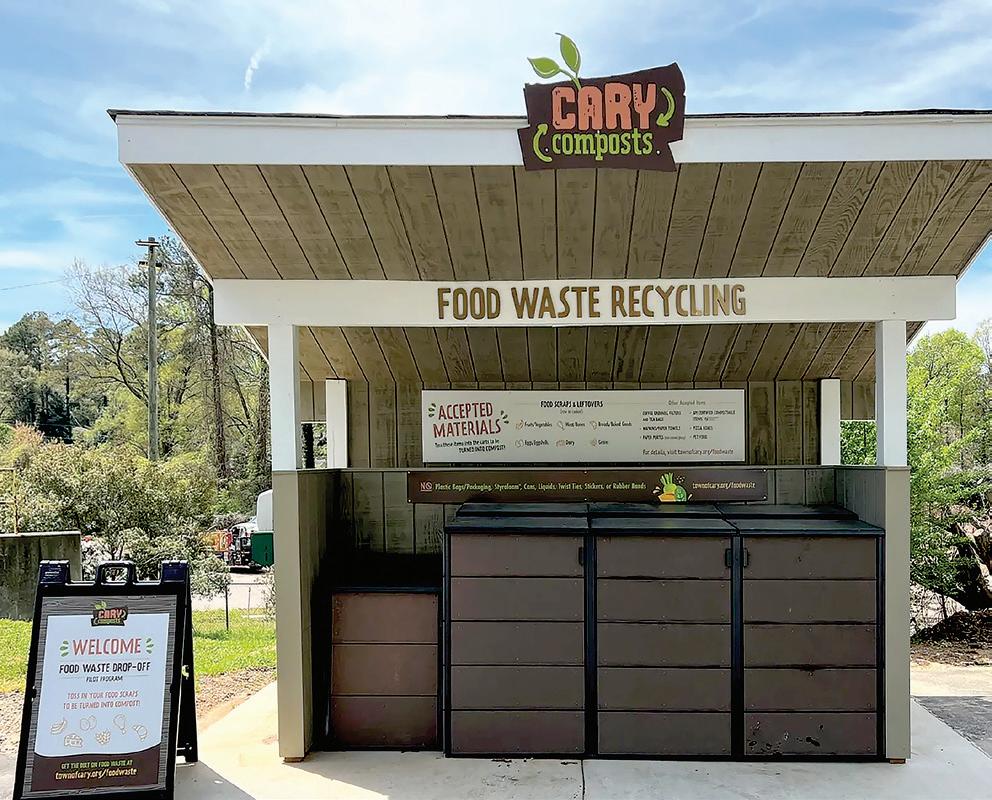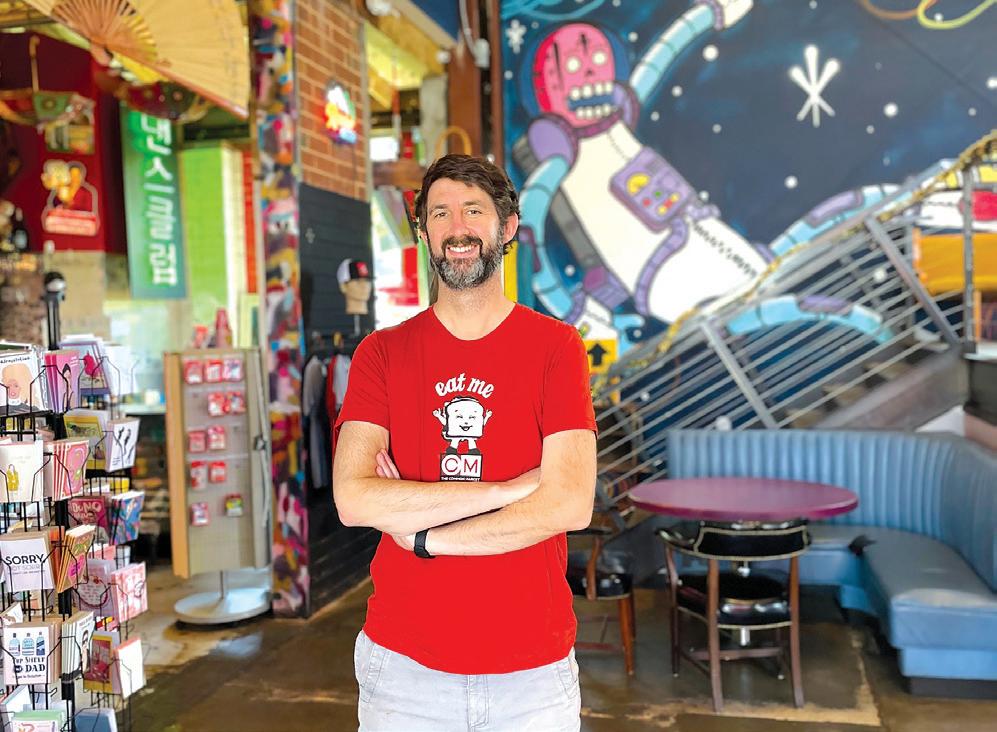
































Thousands of students from other countries are graduating from Durham Public Schools without learning English. The district is promising to do better.



VOL. 40 NO. 14
6 An eyewitness described an assault directed at Durham's mayor pro tem, in which two council members were hit, following a testy city council work session last month. BY THOMASI MCDONALD
8 Cary's new food waste drop-off pilot is diverting tons of food waste from landfills to create compost. BY WILL ATWATER
10 Despite the school system's promises to do better, thousands of students from other countries are graduating from DPS without learning English.
BY GWYNETH BERNIER13 The Common Market, a favorite neighborhood hangout spot in Charlotte, comes to Durham. BY LENA GELLER
14 “Not sleeping and being tired all the time affects your mood and changes your relationship to people, work, and creativity," says musician Chessa Rich. Her album Deeper Sleeper releases on April 7. BY NICK MCGREGOR
THE REGULARS
3 Backtalk
4 Op-ed | Drawn out
16 Culture calendar
CORRECTION Doreen Colondres has not officially earned the title of sommelier, as was incorrectly stated in last week's issue of INDY Week.
COVER Photo by Jeswin Thomas via Unsplash
PUBLISHER
John Hurld
EDITORIAL
Editor in Chief
Jane Porter
Managing Editor
Geoff West
Arts & Culture Editor
Sarah Edwards
Staff Writers
Jasmine Gallup
Lena Geller
Thomasi McDonald
Copy Editor
Iza Wojciechowska

Interns
Sarah Innes, Nathan Hopkins
2023 INDYweek.com
Contributors Spencer Griffith, Brian Howe, Kyesha Jennings, Jordan Lawrence, Glenn McDonald, Nick McGregor, Gabi Mendick, Shelbi Polk, Dan Ruccia, Rachel Simon, Byron Woods
CREATIVE
Creative Director
Nicole Pajor Moore
Graphic Designer
Izzel Flores
Staff Photographer
Brett Villena
Houda Idrissi performs at Local 506 on Saturday, April 8. (See calendar, page 16.) PHOTO COURTESY OF LOCAL 506
ADVERTISING Publisher
John Hurld
Sales Digital Director & Classifieds
Mathias Marchington
CIRCULATION
Berry Media Group
MEMBERSHIP/ SUBSCRIPTIONS
John Hurld
INDY Week | indyweek.com
P.O. Box 1772 • Durham, N.C. 27702 919-695-4848
EMAIL ADDRESSES
first initial[no space]last name@indyweek.com
ADVERTISING SALES advertising@indyweek.com Raleigh 919-832-8774 Durham 919-286-1972
Classifieds 919-286-6642
B A C K T A L
KLast week for print, Jasmine Gallup reported on Raleigh’s missing-middle housing policy and some changes the Raleigh City Council could consider making to the policy. We received the following letter from NATHAN SPENCER, the executive director for local housing and transportation advocacy nonprofit Wake Up Wake County, to members of Raleigh’s city council and thought this excerpt was worth sharing.
“… One of the many challenges in planning for the growth we have experienced and continue to see is that no one block, or neighborhood, city, or region exists in a vacuum. Our goals to build a world-class public transportation system are dependent on having enough people along the high-use corridors to support the bus rapid transit lines. Managing our skyrocketing cost of living is dependent in part on having reliable, frequent, and affordable transportation options that don’t lock-in Wake County residents to an automobile-dependent life. And how we shape our city affects not only Raleigh, but patterns of development in the surrounding region, which historically has contributed greatly to the ongoing climate crisis.
This is why we have long supported “Missing Middle” policies that can serve as one tool in the policy toolbox available to Raleigh as it works towards fulfilling its long-term goals of establishing a socially, economically, and environmentally sustainable community. No ordinance is perfect, and we feel the robust discussion about the policy changes that were passed by the previous council is healthy and an important conversation for the community to have. However, we strongly urge the council to avoid weakening the ordinance in a way that would revert to the previous status quo that primarily encouraged single-unit housing over large swaths of the city. This historical development pattern has resulted in many negative outcomes for our community, from an absence of walkable neighborhoods, to a lack of affordable housing options for young families, and high levels of climate polluting greenhouse gas emissions due to the automobile-dependent development pattern. At a minimum we hope the following aspects of the ordinance are retained:
• The ability to put more homes on the lot including 1-3-plex and townhomes on almost all lots based upon lot size and height, not density per lot.


• Allowing for gentle density with height maximums in all areas, especially since larger single family homes are already as tall in many cases.
• Creating an opportunity for accessory dwelling units (ADUs), cottage courts, and tiny homes that won’t be the final solution to housing affordability, but has proven to help.
• The height bonuses for including affordable housing which, sadly, is one of our strongest tools for getting market participation in the housing crisis.
• Climate-responsible planning to preserve open space and reduce the impact from development.
• The fact that missing middle applies to almost every part of the city. The equitable inclusion of the housing diversity rules is paramount to taking the pressure off of neighborhoods that have experienced gentrification for years. Affordability is everyone’s responsibility.
• The emphasis on transit-oriented development (TOD) around frequent transit areas. This is especially key after our analysis of last years nation-wide BRT study which showed instances where the lack of TOD actually led to the depression in home values. You can read our analysis here: wakeupwakecounty.org/ brt_propval_study/
In addition we strongly support measures that would significantly increase assistance to renters who are being displaced by new development. We believe this is the real crisis facing residents in our region. And given the lack of policy options provided to municipalities in North Carolina, we feel it is imperative that the city invests in a more robust program that helps tenants exercise their rights, and mitigates as much as possible the harm that comes from involuntary displacement ….”

Too many parents know how hard it is to watch their children struggle in school. Often, with the guidance of school staff, we begin the exceptional child (EC) process. You’re given a parents’ handbook that could rival Tolstoy’s War and Peace in length. The assessment begins and you wait. You think you know what you’re getting into, but nothing could prepare you for that “results” meeting.
You hear a lot of numbers. Scale scores, standard scores, t-scores, and percentiles. The first time I was a parent in one of these meetings was four years ago, and I’m still digesting some of the information presented. But there’s one thing they will make sure you understand. Your child has—and by extension you have—rights. Rights to an education that acknowledges your child’s neurodiversity, accommodates their needs, and, as necessary, modifies the curriculum to meet those needs. Your child gets an Individualized Education Plan, an IEP, and that I is the most important part.
Nobody tells you that North Carolina doesn’t provide a sound, basic education for neurotypical students, much less their neurodivergent students. If you watch the appropriations meetings, they plainly discuss that the state gives districts a certain amount for every student with disabilities, unless that’s more than 13 percent of the student population. Since the average across all North Carolina school districts is 14 percent, you can imagine it often is.
Nobody tells you that many schools don’t have EC teachers right now. You hear the promise that your child’s needs will be met without the acknowledgment that there are 40 vacancies for EC teachers and 42 “EC - other” vacancies across Durham Public Schools (DPS). They don’t tell you that this “legal document” will be tossed to the side so swiftly. These supports that we all agree our children need just disappear like pencils in a kindergarten classroom. But our children’s needs don’t go anywhere. They don’t become neurotypical because we will it so. Our EC teachers, who had difficult jobs before, balancing incredible paperwork demands with equally demanding students, are at their breaking points. Many of them choose to be in the general education classroom or leave education altogether. Our EC system is in crisis, and a group of students who are already so vulnerable are paying the price. It’s especially concerning because having a disability is not mutually exclusive with having other marginalized identities. In fact, so many of our disabled students in DPS are also Black, brown, gender and sexual minorities, and/or have limited English proficiency (see report on page 10).
As a parent, it’s hard to know what to do. Your child has rights, they said. You have rights. I’m thankful for the organizing power of Every Child NC in advocating for the rights of every child. But the reality is that it’s just not enough. We can’t keep waiting on a state legislature that refuses to prioritize our most marginalized students. As a parent and education advocate, I have been happy to work with the People’s Alliance in advocating for differential pay for our EC teachers, to acknowledge the value of the extra work and responsibilities that come with their position. This alone
won’t dig us out of the crisis we’re in. But we also can’t keep things the way they are when only 17 percent of students with disabilities are proficient on state exams and a whopping 33 percent don’t graduate with their cohort. W
You can help ensure all children in DPS get the support they need by emailing the Board of Education and County Commissioners in support of a living wage for classified staff and EC differential pay by visiting http://actionnetwork.org/ letters/2023-budget-request.
BY STEVE DAUGHERTYEACH MONTH WE DONATE 20% OF GROSS SALES TO CHARITY!
This month we proudly sponsor: kidstogethercary.org

Our April mobile drop o events: SAT 4/8, 12-2 PM 305 Colonades Way, Cary
SAT 4/15, 12-2 PM

5209 Sunset Lake Rd, Holly Springs
SAT 4/22, 12-2 PM 924 Gateway Commons Cir, Wake Forest

SAT 4/29, NO EVENT
My 51st Birthday!
WE RECYCLE ELECTRONICS, PLASTICS, CARDBOARD, GLASS, METALS, ETC...

anythingwithaplugrecycling.com
919-610-3465

An eyewitness described an assault, directed at mayor pro tem MarkAnthony Middleton, that resulted in DeDreana Freeman hitting mayor Elaine O’Neal and council member Leonardo Williams.
 BY THOMASI MCDONALD tmcdonald@indyweek.com
BY THOMASI MCDONALD tmcdonald@indyweek.com
Days after an ugly, profane standoff last month at Durham City Hall between Durham’s mayor pro tem Mark-Anthony Middleton and council member DeDreana Freeman, a source who witnessed the confrontation tells the INDY that Freeman punched two council members, including the mayor, while trying to attack the mayor pro tem after the March 23 work session.
Of four people involved in or confirmed to have witnessed the confrontation, two confirm this source’s accounting of the events to the INDY
Freeman has not publicly disclosed or denied the reports that, along with the litany of profanities she shouted at Middleton, she tried to attack him when they ended up in a room next to the city council dais out of the view of the WRAL camera that chronicled audio of the incident.
While in the adjoining room, Freeman threw down the items she was carrying, including a bottle of water, and “went after,” or tried to physically attack, Middleton, according to the eyewitness source, who asked to remain anonymous.
Instead of landing punches on Middleton, Freeman ended up punching council member Leonardo Williams twice in the face. The eyewitness source says Freeman also struck mayor Elaine O’Neal once in the face when the former judge tried to intervene.
The source says Middleton and Freeman were in a room behind the council chambers when she first “went after” Middleton by “putting her finger on his chest.”
“Mark-Anthony never touched her,” the source tells the INDY.
The mayor told Middleton, “If you’ll be quiet, she’ll be quiet,” according to the source.
“DeDreana was still shouting. She tried to hit Mark. She swung several times,” the source says.
The source says Freeman did not calm down until Williams, with tears in his eyes, restrained her by pinning her to a wall in city hall.
Late last Tuesday night the INDY first learned that Freeman reportedly had to be restrained from attacking Middleton. That night, Freeman responded to a
request from the INDY for comment and stated via text message that she has a civic duty to honor “the implicit contract between the government and the people.”
Freeman added that as a member of the city council, she is “held to an even greater charge as a mother and role model.”
Freeman described the fracas between her and Middleton as an “unfortunate moment off-the-record” that was “made for public fodder.”
“There is never an excuse for profanity,” she said. When the INDY asked in a follow-up if she had to be physically restrained from attacking Middleton, she sent the following in a text: “Please [refer] to my statement. Have a good evening.”
On Friday, the INDY followed up with an email to Freeman detailing the source’s eyewitness account of what transpired. “We all need to remain focused on the work and moving forward,” Freeman wrote in response. She added that she stands firm in her original statement to the INDY last week and has no further comment.
The mayor, along with Middleton and Williams, all declined to comment when asked about the allegations that Freeman was throwing blows in the back room. The council’s three other members—Monique Holsey-Hyman, Jillian Johnson, and Javiera Caballero—were not present in the room where the incident took place.
The roots of the profanity-riddled argument and alleged physical attack were foreshadowed during the work session. About 23 minutes into the meeting, the mayor read a statement from city attorney Kimberly Rehberg announcing that, on March 13, Rehberg informed her and the other council members that a private property
developer had reported to a city staffer that a council member running for election in the fall allegedly suggested they would support the private developer’s land use plan if the developer donated to the council member’s election campaign.
The mayor instructed Rehberg to consult with lawyers and faculty members at the UNC School of Government, and consulted with members of the school of government herself, to receive guidance on how to address the allegations.
O’Neal met with council members in small groups on March 20. It was the consensus of the majority of the council members, the mayor said during the meeting, to refer the matter to state law enforcement for potential criminal investigation.
Although the mayor did not identify Holsey-Hyman as the target of the probe, reports identified her as the council member in question.
During those small-group meetings, council members confirmed, they also discussed with the mayor allegations reported to them via emails from city staff that Holsey-Hyman improperly engaged two different city staff members to work on her fall election campaign as well as ways to address those actions.
One such incident is alleged to have happened in September, in which Holsey-Hyman—who was appointed unanimously to her current post on May 5 of last year after former council member Charlie Reece moved out of the country with his family—asked a city staffer to research Durham PACs and other organizations related to political campaigns. The other conversation allegedly took place in January; Holsey-Hyman asked a city staffer
about potentially working on her campaign if she ran for office this fall. In March, the staffer sent an invitation using their personal social media account to a Holsey-Hyman campaign event during work hours.
To address the allegations, the UNC School of Government recommended options that included referring the matter to the State Bureau of Investigation, investigating internally, formally censuring Holsey-Hyman, or doing nothing, council members said.
Johnson says that, following the small-group meetings on March 20 with the mayor, she volunteered to write a resolution censuring Holsey-Hyman for her behavior with city staff around her political campaign.
The resolution states that Holsey-Hyman “is expected to uphold the public trust of the residents of the City of Durham by following all federal, state, and local laws as well as city policies.”
Additionally, the resolution points to the state’s general statute that “prohibits city employees from engaging in partisan or political activity in the workplace or with city resources, and from using their official authority or influence for the purpose of interfering with or affecting the result of an election.”
In a statement in her defense made during the work session, Holsey-Hyman said that in September she was trying to gather information from a staff member about different PACs and resources in the city “to educate myself about organizations in Durham.” She said she was informed that the request was considered campaign-related research and that it was dealt with between herself, the staff member, and the staffer’s supervisor.
In the second incident, Holsey-Hyman said, a city staffer discussed their experience as a former candidate and their previous work on city council campaigns and offered to assist Holsey-Hyman if she decided to run for her seat in the fall.
Johnson and other council members told the INDY they assumed the mayor would bring up the resolution during the work session, but when she did not, Johnson says she took the initiative to do so during the “other matters” portion of the council meeting following the work session’s scheduled items.
O’Neal appeared to be irritated by Johnson bringing up the resolution.
“Last night, I did receive a draft of a resolution from a council person that had my name down as a signee,” O’Neal told her fellow council members after Johnson read the document. “From my understanding, a resolution had never been signed, and I ask that my name be removed from that resolution.”
O’Neal added that she would “admonish anyone who uses my signature in a manner that I didn’t give permission … to know you do not have permission to do that.”
Johnson says the template she used for the censure resolution was signed by a different city’s mayor, “and so my initial draft included a blank line for [O’Neal’s] signature.”
“It obviously did not include her signature because she would have had to sign it,” Johnson wrote in an email to the INDY . “I removed the blank signature line at her request.”
Still, it looked to some other council members like the mayor was allowing Johnson to take the fall for bringing up the resolution of censure that the majority of council members had agreed upon.
In an email to the INDY Friday, O’Neal said she has “no comments regarding this matter.”
After Johnson—who said during the work session that she had been “up until four in the morning literally panicking about this situation”—brought up the resolution to formally censure Holsey-Hyman, Freeman called the proposed resolution “troubling.”
Freeman said during the work session that the manner in which the resolution was used misrepresented Holsey-Hyman and that Holsey-Hyman’s explanation of the staffer receiving approval from the city’s human resources department to assist her with researching local PACs was “dismissed [by other council members] in a very matter of fact way.”
Freeman said that although women comprise five of the seven city council seats, their comments are “often dismissed whenever a woman is speaking at the [city council] dais.”
Middleton said during the work session he took issue “with the bizarre allusion to gender with the number of women on the dais, one of whom holds the gavel, and one of whom wrote this resolution.”
“So, as one of two men on the board, what?” he added. “What does that even mean?”
“You’re a bully,” Freeman replied. “It means stop bullying women. Stop being a bully. Stop being a bully. Stop! Bullying women. That’s what it means.”
“You close to the line,” Middleton replied.
“You close to the line,” Freeman answered.
“Again,” Middleton said, “a female colleague has drafted a resolution about acts that touch on ethics and legality, and there’s five women on the council. So that’s a moment for me that’s hard to follow.”
What followed after the testy work session certainly crossed the line and was truly bizarre, even considering that a raucous brand of democracy is a feature and not an aberration of Bull City politics.
The angry post-work-session confrontation between Middleton and Freeman began with the two shouting at each other outside the city hall chambers. O’Neal and city manager Wanda Page were seen on-camera leaving the council’s dais, and the mayor tried to placate the heated exchange.
“Hey, hey, hey,” the mayor said in an unsuccessful attempt to squelch the confrontation.
But then four council members walked into the room next to the council dais, where they were out of sight but clearly within earshot. Freeman can be heard loudly telling Middleton, “Get off of me! Get off of me!
“This is how you treat Black women! This is how you fucking treat Black women, and it hurts!”
“Wait, wait,” O’Neal is heard saying.
“I’m done! I’m done!” Freeman said. “No, I don’t care. ’Cause he’s full of shit! Full of shit!”
“She listens to you,” Middleton can be heard saying, alluding to Holsey-Hyman. “She listens to you. The mayor listens to you.”
“What she need to listen to me for? She got a fucking brain of her own. She can listen to her damn self!” Freeman replied. “She can think for her fucking self. If you didn’t think she was smart enough, why the fuck did you vote for her [onto the council]? … She’s not fucking dumb. She can think for her fucking self! Just like every single woman here!”
The two-minute-and-18-second video ended with O’Neal heard in the adjoining room calming down the argument between the two council members.
Last Tuesday, Middleton wrote in a social media post that, while he has served as Durham’s mayor pro tem, “there has been a deliberate, relentless, coordinated, sustained, and mean-spirited attempt to foster a narrative that I am somehow anti-Black Woman.”
He explained that the narrative “has been promulgated by some elected officials and community members in hopes that it would color the public’s perception of me.”
“It is not a large group of people, but it is a very vocal and committed group set on convincing the thousands of Black women and others who voted for me that they have somehow been duped,” he wrote.
Middleton may be referring to a blog post headlined “City Council Member DeDreanna [sic] Freeman Says She Will Always Fight a Bully,” published by the journalist Carl Kenney on his blog.
Kenney wrote that Freeman’s “profanity-filled outburst after a recent city council meeting is her response to the actions of a bully.”
“It matters that Johnson, a Black woman, wrote and read the proposed resolution to censure Holsey-Hyman,” Kenney wrote. “Freeman’s profanity-laced attack, combined with Middleton’s response, places Black women in the center of a conversation involving what it means to protect the hearts of Black women.”
Middleton said the accusations are “a cynical insult of the intelligence of the people of our city, and a dangerous perversion and weaponization of the sacred struggle of the generations of Black women who have fought to step in the light, including the one who raised me.”
“The mayor needs to lead,” the anonymous source who detailed the March 23 confrontation says of O’Neal, who was elected in 2021 as the city’s first Black woman mayor. “Her council is falling apart.”
Meanwhile, Middleton says he is “deeply saddened” by the ugly confrontation, adding, “As we near the end of her first term, the only legacy for the council [and O’Neal] will be discord and dysfunction.
“I didn’t want that for her.” W
“As we near the end of her first term, the only legacy for the council will be discord and dysfunction. I didn’t want that for her.”
Cary’s new food waste drop-off pilot is diverting tons of food waste from landfills to create compost.
BY WILL ATWATER backtalk@indyweek.comCary’s Good Hope Farm manager Thomas Saile appreciated a recent warm spell.
“This week we had some nice warm weather and were able to get our first tilling in for the season, [which] breaks up last year’s crop residue and helps with drainage and aeration,” he said. “After that, we began applying our compost to the field.”
Establishing healthy soil is an important first step in the process of growing vegetables. Adding decomposed organic matter—compost—to soil infuses it with nutrients plants need to produce high-quality vegetables. Fortunately, Good Hope Farm has a new source of compost this year.
In 2022, the Town of Cary established a pilot food waste drop-off program to divert food waste from the landfill and to create compost now used at Good Hope Farm. The
response surpassed expectations, and “the pilot’s initial goal of collecting a minimum of 16 tons of food scraps resulted in an actual collection of 40 tons,” according to a release published earlier this month.
Despite early success, assistant town manager Danna Widmar knows more buy-in is needed to grow the program.
“While we continue to see increased use, we know not everyone was an early adopter. We encourage citizens to try it out if they haven’t yet,” she says.
Diverting food waste from landfills is a goal Widmar shares with the global environmental and scientific communities, which are concerned about the connections between food waste, a warming planet, and environmental and health problems.
Food waste buried in landfills breaks down in an oxy-
The Town of Cary recently completed a one-year food waste pilot program, which involved residents dropping off food waste at the location pictured left.

gen-deprived environment, producing methane as a by-product. Recently, NC Newsline (formerly NC Policy Watch) reported that the Sampson County Landfill ranks number two in the nation for methane emissions.
“Depending on whether you’re [measuring] by a year or 20 years, [methane is] a much more potent greenhouse gas than carbon dioxide,” said Nora Goldstein, composting expert and editor of BioCycle, a compost science journal. In addition to methane, landfill-deposited food waste produces 170 million metric tons of carbon dioxide emissions, matching the yearly carbon dioxide output of 42 coal-fired power plants, according to a 2021 Environmental Protection Agency report.
The report also states that “food waste is the single most common material landfilled and incinerated in the United States, comprising 24 and 22 percent of landfilled and combusted municipal solid waste, respectively.” Additionally, the report said, “food loss and waste represent 8 percent of human-generated greenhouse gas emissions each year.”
Researchers have warned that climate change will threaten world economies by disrupting product supply chains, reducing global food production, and causing mass population displacement, among other negative impacts.
The effects on human health are predicted to include increased respiratory and cardiovascular disease, more diseases transmitted from insects, and more heat-related deaths and other negative outcomes.
The NC Department of Environmental Quality (DEQ) has a map on its website that shows the location of compost facilities across the state. There are more than 50 sites on the map, representing a mixture of private and govern-
ment-run composting facilities. But it’s not clear how many of the facilities compost food waste.
In addition, DEQ is providing approximately $393,000 in grant fund support to local governments, nonprofits, and businesses to help divert food waste from landfills. The funding opportunities are made available on an annual basis.
One facility that’s listed on DEQ’s NC Food Donation and Compost Resource Map is roughly 250 miles west and slightly south of Good Hope Farm in Henderson County. The Henderson County Convenience Center is where residents can drop off recyclables. The county operates a transfer station and ships its garbage across the border to a landfill in South Carolina, paying roughly $40 per ton, according to Amy Schmitte, county environmental programs coordinator.
In 2017, the convenience center began a food waste drop-off program. By 2022, the facility had diverted 142.5 tons of food waste from the landfill, Schmitte said. Though the current savings is less than 1 percent of the waste management budget, the county continues to work toward expanding the compost facility and diverting more food waste from the landfill, Schmitte said.
“We accept typical food waste, but we can accept some other items that you won’t typically be able to compost at home, which is nice for folks,” Schmitte said.
Through a process known as aerated static pile composting, air is pumped from perforated pipes beneath the compost pile. The air stimulates oxygen-craving beneficial organisms that feed on the waste. During this process, the pile’s core temperature reaches 131 degrees for a 10-day period, which is hot enough to kill pathogens—even those found in meat scraps and dairy products. Pizza boxes and other paper items are also composted, according to Schmitte.
Currently, the only outlet for the finished compost is the grounds of the solid waste transfer site. Schmitte says that additional testing is needed to ensure that all pathogens are eliminated during the composting process before other outlets are considered.
Another food waste composter, Brooks Contractor in Goldston, is a private business that uses windrows to transform food scraps into compost for its clients. Amy Brooks, assistant facility manager, said that, on average, it takes about a year to produce compost. The process involves mixing “food waste with wood waste, animal bedding, and leaves,” she said.
Once the ingredients are mixed, they are spread out into windrows, where they are turned at least five times over a three- to sixmonth period, Brooks said. During this time,

the pile’s internal temperature must surpass 131 degrees to ensure that pathogens are killed. Afterward, “the windrow is moved to a curing pile.” Later, after a screening process that removes clumps and debris, the compost is ready to be sold, she said.
North Carolinians who don’t live in communities that offer food waste composting can establish a home composting system. For those who have yard space, there are plenty of composting bins and tumblers on the market that range in size and price. Good Hope Farm offers composting workshops and sells containers that will produce roughly one cubic yard of compost.
“This [container] would be something that someone could put in their backyard. It’s got a nice little lid, it’s got a stirring tool that comes with it to keep it aerated. And this is perfect for a general household,” Saile said.
Saile also encourages first-time composters to take a composting workshop “because there’s a few ways you can go wrong. [The pile] can be too wet, or it can be too much green (nitrogen) or too much brown (carbon),” which slows down the decay of the food scraps. However, Saile said, when a bin is properly layered, the pile only needs to be turned occasionally to promote the composting process.
Goldstein warns, however, to avoid adding “meat, fish, or dairy to your backyard bin because the temperatures in your compost don’t get hot enough to destroy pathogens.” Companies such as Compost Now, which is in Raleigh, provide a food waste collection service for a fee and accept meat and dairy scraps—often in exchange for access to compost for household use.
Many householders are put off by collecting compost in the kitchen, which can also collect insects that are drawn by countertop food waste containers. One way to avoid that is to store food scraps in a bag in the freezer until you’re ready to add them to the outdoor bin, Goldstein and Saile said.
While Goldstein is encouraged by the growing number of municipalities that are establishing food waste drop-off facilities, she would like to see things move at a faster pace—especially “given what we know about … the challenges with food waste in the landfill.” W
This story originally published online at NC Health News. North Carolina Health News is an independent, non-partisan, not-for-profit, statewide news organization dedicated to covering all things health care in North Carolina.



Thousands of students from other countries are graduating from Durham Public Schools without learning English. The district is promising to do better.
BY GWYNETH BERNIER backtalk@indyweek.comOn his first day at Durham Technical Community College in September 2021, 19-year-old freshman Shahid Ali was lost in every sense of the word.
He wandered around campus, furiously typing building names into his Google Translate app. Grabbing random students and professors, he insistently pointed at his schedule. With pitying smiles, they chirped incomprehensible phrases in English too quickly for him to understand and shuffled along with their day, leaving him bewildered.
The frenzy of colorful banners, student organizations, and professors whirred around him; everyone seemed to know exactly where to go and what to do. Ali arrived at his first class with five minutes left in the period, holding back tears.
“That’s a hard memory,” Ali recalls with a shudder, closing his eyes. “I tried to keep smiling and stay positive like I always do, but it was hard.”
When Ali fled Afghanistan as a refugee in 2017, he and his family were resettled to the refugee hotspot of Durham, North Carolina. Just two months after his plane touched down at Raleigh-Durham International Airport, Ali started as a freshman at Jordan High School knowing only a few words of English. When he graduated, he had barely learned a few more.

Ali’s story is typical of the fastest-growing student group in Durham: English learners, students from other countries who speak a language other than English at home. This school year, English learners make up one in six students in Durham Public Schools. Yet they lag far behind their peers in academic achievement, struggling with basic English comprehension.
Last year, test scores among Durham Public Schools’ English learners were among the lowest in the state—106 of 115 districts, while scores for DPS’ white students were the fourth best in the state. Meanwhile, performance by nonwhite, English-speaking students was in the middle of the pack.
This is despite the fact that the Durham school system was challenged in court five years ago over its service to English learners.
Durham Public Schools Assistant Superintendent Stacy Stewart says that the school district is aware of the poor performance by English learners and is putting new improvement plans in place in response. “Moving forward, we have a plan based on research to increase English learner student performance and bring parents into conversation.”
When Ali started his freshman year at Jordan High School, he only spoke Pashto, one of Afghanistan’s two official languages. Trekking miles through Afghanistan’s mountainous terrain to school with his younger sister came naturally to Ali. Navigating DPS route maps to find where to catch the bus? Not so much.
“Everything was so different, and I didn’t know anybody,” Ali recalls. “The people at Durham Public Schools, they don’t really make an effort to make sure the families and students understand where to go or what to do.”
Ali’s struggles continued even after he figured out how to get to class.
“My English [as a second language] teachers just talked at me and wrote things on the board rather than helping me participate like I did at school in Afghanistan,” says Ali.
“I didn’t know enough English to ask my teachers to slow down or tell them I couldn’t understand. I’m not sure they even noticed or cared.”
His English as a second language courses frustrated him to the point that he sought other avenues of learning.
“My locker neighbor Ryan and I would skip lunch most days so he could tutor me,” Ali remembers. “On the days he couldn’t, I would watch Friends in the bathroom on my phone with Pashto subtitles. That was much more helpful for me to learn English than my teachers were. It at least helped me get by in school.
Integrated classes like art and gym class were even worse; they made him want to stop going to school altogether.
“When we would play soccer in gym class, I would sometimes see the other kids make fun of me or not want to pick me for their teams because of my accent,” says Ali. “My gym teacher pretended it was not happening.”
By the end of senior year, he could not read at a second-grade level. Yet he was still permitted to graduate from high school in 2021.
Paradoxically, while few English learners in Durham Public Schools reach even basic academic proficiency, they still graduate on time. Sixty-one percent graduated in four years from Durham Public Schools in 2022.
The numbers do not surprise Assistant Superintendent Stewart.
“We’ve seen the data and this is unfortunate…,” Stewart said. “We all have work to do…It’s not just the job of the ESL teachers, from K-12 we’re implementing processes and strategies so that students are engaged, excited, and coming to school immersed in classroom work and overall
language development.”
Stewart also pointed to the COVID-19 pandemic as a factor in poor student performance.
“The biggest challenge at this moment is the challenge of mitigating COVID-19. How do we make up for learning loss from students being online?”
But Durham Public Schools’ leadership recognized achievement gaps within the school system prior to the pandemic. At the end of 2017, superintendent Pascal Mubenga announced a five-year strategic plan to bridge the learning gap between the district’s high and low-performing student groups. The plan calls for at least 60 percent of all DPS students to achieve grade-level reading and math proficiency on end-of-grade tests by the end of 2023.
At a district-wide administration meeting in July 2021, Mubenga called the strategic plan a “powerful spark” in the school system post-pandemic.
“The plan creates a vision of equity in which students’ identifiers are no longer an accurate predictor of their academic outcomes,” Mubenga said with a booming voice, to snaps and whoops from the audience. “It marks a new beginning for [Durham Public Schools] that will lift up every student, without exception.”
Yet gaps persist. Last school year, less than a fifth of English learners at Durham Public Schools had reading and math scores at grade level, compared to 80 percent of its white students and half of its nonwhite English-speaking students.
During equity discussions at school board meetings, administrators mention English learners infrequently compared with other groups, despite English learners being the lowest-performing group by a wide margin. English learners also receive little attention in the school system budget. This fiscal year, $5 million was specifically allocated for English learners in Durham Public Schools’ $684 million annual budget.
In school board meetings, district administrators have said that inadequate funding and a linguistically diverse population explain English learners’ weak academic performance.
Durham Public Schools is indeed linguistically diverse. The vast majority of the system’s English learner population speaks Spanish, but the remaining students speak a wide variety of other languages, including Arabic, Farsi, French, Vietnamese, and Mandarin. The district currently employs 18 Spanish translators. There are no translators on staff for languages other than Spanish.
Still, other North Carolina school districts have similarly large and diverse populations. Compared with students in those districts, English learners at Durham Public Schools perform significantly worse. At Charlotte-Mecklenburg Schools, for instance, non-English speakers make up nearly a third of the total student body and speak 204 different languages. Yet English learners at Charlotte-Mecklenburg display significantly higher year-end test scores than English learners at Durham Public Schools.
“We are not happy with the data from last year,” Stewart said in response. “We know that COVID negatively impacted our efforts.”
Stewart also said the district has plans in place to improve programs for English learners, including a new Family Academy that provides foreign-born parents and students with additional in-person instruction on weekends.
“In January, we started to implement school improve-
ment plans and inspections on a day to day basis,” she said. “Those include the four points tested on year-end exams: English reading, writing, speaking, and listening comprehension. We’re also working on the new English learner prep and family academy.”
Civil rights lawyer William Tobin thinks these are important steps, but “too little, too late.” For more than a decade, Tobin ran Duke University’s Citizenship Lab, a volunteer tutoring program that served hundreds of refugee students in Durham, including Ali.
Tobin initiated the aforementioned 2018 lawsuit against DPS on behalf of a Riverside High School English learner student. By June of his senior year, the student was reading at a first-grade level. Nevertheless, he was granted a high school diploma. The lawsuit, which was ultimately settled out of court, resulted in Durham Public Schools paying for a year of remedial English instruction for the student at Durham Tech.
Tobin says not much has changed since the lawsuit was settled out of court in 2018.
“Key metrics of English learners’ academic success in the school system are still just as bad and have never been in the neighborhood of okay,” he says. “What Durham Public Schools still desperately needs help with is the most basic, and vexing challenge: assistance on how all of us can live out every day—and not just talk about and mentally agree with—the truth that English learner students are intelligent and going places.”
The lawsuit was settled before Ali finished his sophomore year in high school. Yet Ali still didn’t learn English in high school.
And that wasn’t the only way the system failed him. He also wanted to learn skills, like basic algebra, that would open doors for him in college and career.
As an English learner, Ali was shunted into English-as-asecond-language courses with other English learners and isolated from the rest of the student body.
These courses are intended to benefit non-native speakers, with a slower pace and greater focus on vocabulary. However, the courses are meant to be transitory, lasting for a year or two upon a student’s arrival. They do not cover all the content needed to prepare students for standardized tests and the rigors of a college education.
At Durham Public Schools, English learners exit English as a second language courses by scoring high enough on year-end exams. Unfortunately, most do not make enough progress on year-end exams to do so. As a result, most English learners miss out on a wide range of courses. This lack of access to key knowledge bases severely limits their college and career options.
Azana Green says communication issues are a big part of the problem. She saw that firsthand while working at the Lincoln Community Health Center, which provides health care and social services for marginalized groups in Durham, including migrants. According to Green, English learners’ families were often the last to know about academic opportunities and classes, resulting in those students being shut out or missing deadlines.
“Durham Public Schools would call newcomer families from the hours of 9 a.m. to 5 p.m. unannounced and expect the parents to have several hours to work through forms,” she said with a sigh. “That’s just not possible for a family trying to get on their feet with the mom and dad respec-
tively working long hours as a nail tech and cab driver.”
“From student registration to assessments to parent-teacher conferences, there was way too much red tape. They had to know that if I, a native English speaker, found the forms confusing, English learner families would, too.”
But lack of communication wasn’t the only issue—the messages the school system did send were problematic, too.
In the fall of his senior year, Ali realized he was only enrolled in three classes rather than the typical four. He brought up his concern with his guidance counselor. She dismissed his worries.
“[My counselor] said it wasn’t a problem because I would still graduate with the required number of credits,” Ali remembers. “But I knew it meant I wouldn’t meet the requirements for college admissions. She didn’t see a problem because I already had a job at Lowe’s.”
During high school, Ali began working part-time hours as a Lowe’s cashier. He didn’t see it as a permanent career, just a way to save money for college.
Durham Public Schools English learners typically must take remedial courses first.
Even within remedial courses, Burns says that English learner students from Durham schools have weaker language skills than other students.
“My colleagues and I find it distressing that these students who have taken four years of high school come to Durham Tech with no knowledge of simple English capitalization and punctuation rules,” says Burns. “Those of us who have volunteered at Durham Public Schools in our free time know it’s because the teachers and administration there share a rubber stamp mentality. For them, it’s about letting English learners pass and move on without insisting they master basic English skills. There’s zero accountability.”
Ali took Burns’ class in his freshman year in 2021. By the end of that semester, he was overjoyed to be able to read articles and watch the news in English.
How did Ali become English proficient in just one year at Durham Tech when he was unable to do so at Durham Public Schools in four? Burns cites two key factors: faculty experience and teaching style.
“In 2012, when the English learner population really started growing in Durham, English as a second language department director Paula Wilder started to recruit and retain incredible talent [at Durham Tech]. Many of our 17 faculty members earned doctoral degrees, speak a variety of languages, and have considerable experience teaching languages overseas,” says Burns, who spent years teaching English in Beijing, China.
Some experienced teachers may be drawn to teaching at a college level rather than in K-12 schools. But professors at Durham Tech also take a totally different approach to teaching English.
“In line with current research, we avoid lectures and instead focus on a student-centered approach that emphasizes individual participation and group activities,” says Burns. “We also carefully monitor student progress. I would never pass a student who didn’t have the tools to succeed.”
Durham Tech professors like Burns have recommended Durham Public Schools adopt its methodology. Yet the school system has not yet changed its approach.
Meanwhile, more students like Ali keep arriving at the schools’ doorsteps. One of these students is Ali’s little sister, Farishta.
Ali refused to let himself be “talked into failure.” Now, he strolls around Durham Tech’s campus, joking in English with friends. Confident in his ability to pick up new languages, he’s on his way to Spanish 101.
He’s proud of becoming fully proficient in English in two years at community college. He plans to transfer to UNC-Greensboro next fall to pursue computer science. But it will take him three years to obtain a two-year degree from Durham Tech before transferring, and that third year will cost him an extra $4,000 in tuition money.
It’s not just Ali. One in five English learners who graduate from Durham schools head on to college. Yet they face several years and thousands of dollars in setbacks, because they often can’t enroll in college courses immediately after graduation.
Adam Burns has taught remedial English language courses at Durham Tech since 2016. Most English learners from school districts across North Carolina matriculate directly into credit-bearing courses, he says. In contrast, he says
“I worry for my sister Farishta who still goes to high school at Jordan,” Ali says. “I try to help her with English at home. She wants to go to medical school to be a doctor and help people, but I am scared she won’t get the chance.” This problem isn’t going away soon. Currently, English learners make up roughly 10 percent of all U.S. public school students, and that number is expected to hit 25 percent nationwide by the end of the 2020s.
These figures don’t have to mean impending doom. Despite the obstacles he faced, Ali is a testament to what’s possible. He’s excited about his upcoming graduation from Durham Tech in May.
“This time,” he says, “I’ll be able to understand the speeches.” W
This story was published through a partnership between the INDY and 9th Street Journal, which is produced by journalism students at Duke University’s DeWitt Wallace Center for Media & Democracy.
“Key metrics of English learners’ academic success in the [Durham public] school system are still ... bad and have never been in the neighborhood of okay.”
In an old office building just off Ninth Street in Durham sits a cardboard box containing a barbershop pole, a lobster trap, antique brass doorknobs and hinges, and a stuffed water buffalo head.
The items have been carefully curated—and, along with the building, will soon be repurposed as part of the expansion of The Common Market, a Charlotte-based deli, bar, and bottle shop slated to open its first Triangle location in a Green Street office space this June.
Graham Worth is leading the Durham rollout. A Raleigh native with a knack for spotting decorative potential in sundry garage sale items, Worth has helped launch three of The Common Market’s other four locations—three in Charlotte and one in South Carolina—and says unconventional wall art, like doorknobs and lobster traps, is an integral part of the brand.
The Common Market started as a convenience store in 2002.
“Blake [Barnes], who founded it, didn’t have enough money to do anything else,” Worth says. “When he cobbled together some money, he added a deli. Then he looked around and realized people liked to drink while they were there, so he built a bar. What it is, in its current state today, all happened organically over time.”
The layout of the Durham location reflects this evolution, in a sense. From the outside, the building is unassuming, almost like a corner store. But its interior—a spacious, split-level concept that Worth created by cutting a giant hole in the ground floor, thus merging it with the basement—is more comparable to a food hall.
The ground floor will be anchored by an all-day, vegetarian and vegan-friendly deli that serves bodega-style breakfast fare, like bacon, egg, and cheese bagels; classic lunch sandwiches, like clubs and grinders; and dinner items that have yet to be determined.
“Our night menu really varies based on the preferences of the neighborhood,” Worth says. “At one store, we do wings,
cauliflower wings, cheesesteaks, and a spicy tofu sandwich. At another store, we focus more on tacos and quesadillas.”
As far as Durham’s dinner menu goes, Worth is open to suggestions. He’s also on the hunt for two local vendors—a coffee purveyor and an ice cream purveyor—to help round out the house menu. Both vendors would operate on-site.
The market will also sell snacks and retail items, like cheeky greeting cards, and its basement will house a bar, a bottle shop with wine and craft beer, and a few arcade games.
The seating—which includes two- and four-tops, bar chairs, a coworking area with couches and wall outlets, and outdoor patio tables—is varied to accommodate the market’s multitude of offerings. There’s even a row of double-sided, indoor-outdoor bar seating, which may appeal to parents of messy eaters or couples who can never agree on the thermostat temperature.
“We want there to be something for everyone,” Worth says. “A while ago, a customer told me, ‘The Common Market is the only place in Charlotte where I feel comfortable no matter what I’m doing or what I’ve just done—I could be coming from a workout, or going to a nice dinner, and I would still feel comfortable.’ I think that really speaks volumes about our ultimate goal, which was to create a community living room.”
For Ninth Street—a mom-and-pop business district that seems increasingly at risk of losing its local flavor and communal spirit to corporate interests—a funky gathering place like The Common Market may be just what the doctor ordered.

Between 2017 and 2019, Ninth Street lost two locally owned businesses that had neighbored each other for nearly three decades.
One was Francesca’s, a cozy café that hosted countless hangouts and late-night study sessions before shuttering due to an exorbitant rent increase. The other—an eclectic clothing store called Native Threads that closed when traffic grew too slow—was known for the copper green frog statues that stood outside its shopfront, perpetually smiling at passersby.
Nowadays, the stretch of Ninth Street that once harbored these businesses is now home to a pick-up-only Starbucks.
It’s hard not to see the Starbucks—which has another location inside the Harris Teeter, across the street—as the soulless specter of its predecessors. Francesca’s comfy booths have been replaced by a sterile coffee pick-up area, bereft of furniture. A few feet from the spot where the frog statues stood, pedestrians now pass beneath a protruding Starbucks logo, which, while also green and smiling, doesn’t feel quite as friendly.
With five locations, The Common Market is technically a chain now, too. But it still has a homegrown Carolinas feel to it, with an individualized spirit and aesthetic to each location.
“None of our stores are the same,” Worth says. “They can’t be replicated. And I think the fabric of Durham aligns with that. There’s a funkiness and a uniqueness and an eclectic vibe that we share.” W
CHESSA RICH W/ SKYLAR GUDASZ
Saturday, Apr. 29th, 8 pm | Cat’s Cradle Back Room | $15
Chessa Rich has been dreaming of this moment for years.
First came the metaphorical dreams: Rich began writing the songs on Deeper Sleeper, in fits and starts in 2017, eventually recording the debut album in March 2021. But it took two more years until the project emerged from its cocoon, dropping this Friday, April 7, on Sleepy Cat Records.
That long stretch aligns with a period of difficult yet vivid dreaming, during which Rich suffered from undiagnosed sleep apnea—a condition that causes a person’s breathing to stop and start throughout the night, preventing the body from getting enough oxygen. In some cases, it induces intense, often terrifying dreams; in others, it causes persistent fatigue. Rich was unlucky enough to suffer a sucker punch of both symptoms.
“Not sleeping and being tired all the time affects your mood and changes your relationship to people, work, and creativity,” Rich tells INDY Week over a freewheeling lunch interview in March at Wilson’s Eatery in Raleigh. “Everything feels more stressful.”
Finally undergoing a sleep test after a lifetime of unsettled rest, Rich received relief: a medical diagnosis that delivered a modicum of self-acceptance, along with a prescription for a CPAP machine to sleep better. “It was super helpful to realize that I’m not just lazy,” she laughs.
But struggling for so long to interpret the surreal symbolism of her dreams while cultivating a career as a working musician who needs 11 hours of sleep a night gave the
34-year-old Burlington native and decadelong Durham resident a singular perspective on “making it.”
“I got so used to waking up and feeling the same amount of tired as I did when I went to bed,” Rich says. “Our culture is all about that ‘rise and grind, entrepreneur!’ mind-set: working, exercising, socializing, partying. But it doesn’t have to be that way. Learning that I had sleep apnea allowed me to be more gracious with myself.”
Deeper Sleeper’s nine tracks are awash in such benevolence. Recorded outside Woodstock, New York, at Milan Hill Studios with producer Shane Leonard, the album is primarily built around catchy piano riffs, the instrument that Rich grew up playing. A tight-knit circle of North Carolina friends— Saman Khoujinian, Joseph Terrell, Alex Bingham, and Jay Hammond—helped her flesh out those compositions with elegant instrumentation.
Propulsive synths and jagged guitars undergird Rich’s unusual vocal stylings on “Paper Heart,” where she stretches simple lines like “I crossed a border / Turning your corner” into syrupy tongue twisters. Lead single “Sleeping Is Easier” is a straightforward banger, with drum crashes and a driving chorus soundtracking Rich’s lamentation that “ringing alarms don’t wake me up” as “I close my eyes and I turn it off / And bite the hand of a ticking clock.”
Offbeat songs like “River” and “Dirty Wine Glass” feature complex bass grooves and skittering beats that match Rich’s intri-
cate lyrics. Call it progressive R&B, symphonic pop, or jazzy alt-rock—Rich says it’s all indebted to shape-shifting influences like Radiohead, Wilco, Loma, and Big Thief.
“I’m an indie kid,” she says, admitting to past struggles fitting in with the Triangle’s dominant Americana and old-time paradigm. “But I don’t want to feel like my music doesn’t have any roots. My friends reinterpret folk songs that are part of this long tradition or canon, and I’m like, ‘Hey, I want that too!’”
Another clear touchstone is the music of Fiona Apple, especially evident on “Red Sky,” which foregrounds Rich’s booming piano and unadulterated voice. The stark

composition tumbles through shifting keys and time signatures before Rich reaches an intense denouement: “I was made for a different time / I’m slower than most / But I think I’m good / I know I’m good.”
Deeper Sleeper is bookended by bops that could easily soar to the top of algorithmic streaming services. On “Wanderer,” Rich narrates a period of living in Spain, in which she longed for connection but also honed her knack for capturing life’s incremental Proustian memories (“The curtains were pleated just like cardboard”; “I sure know how to have a good time / Like a dog following a patch of sunlight”).
“Vacation,” meanwhile, is one of Rich’s
oldest yet breeziest songs. Conceptualized in a hotel conference room on a borrowed guitar while she was selling merch on tour with Watchhouse (then performing as Mandolin Orange), she finished it during a weeklong residency at Wildacres, a retreat center in the Blue Ridge Mountains. Getting accepted, she says, “was divine intervention—truly a life-changing week.”
Six years later, Rich’s life stands to shift again. Her upcoming album release show on April 29 at Cat’s Cradle Back Room is sponsored by WUNC, and she’s elated to get back on stage after a multi-month break. Yet she is candid regarding her anxiety about careerist considerations: marketing, promotion, video budgets, licensing, interviews, and the dreaded social media content-making.

“Creative energy to me is a physical thing,” she says. “I like moving my body on stage with other people. So this promo mode has been messing with my brain. When I’m not playing shows and only living on the internet, I feel terrible.”
Asked about other musical pursuits that bring her joy, she goes deep: jamming with

2018, after celebrating the 2019 release of Rich’s first EP, All the Love Anyone Ever Gave Me, Rich’s mother gifted her one of those paintings to remind Chessa of her own artistic power.
“It made me so emotional to be connected to my grandmother like that,” she says. “I’m a continuation of her art—but I never got to talk to her about it.” Tearing up, she continues: “I want to ask her all these questions: Why did you paint? How did you paint? What made you want to paint?”
Toward the end of “Mary,” Rich threads her own existential questions with those her grandmother may have asked herself. When she sings, “I’ve been recalling more things / My lifetime is in the palm of my hand,” the strength of this generational thread—and the fascinating way she wraps her voice around the word “palm”—cuts deep.
The song continues for two more minutes, clocking in past six minutes in an extended wash of piano, synth, drums, guitar, and bass highlighting again the instrumental mastery of Deeper Sleeper. Will listeners make it far enough, to that moment when
her church band on Sundays, watching her dad play trombone in the Elon University Wind Ensemble, and teaching music lessons—her main source of income over the last few years while also a clear inspiration.
“I want my students to understand how music can help them live in the world,” she says. “I like to work around their idiosyncrasies and what they want to say. That reminds me how to make my own music and helps me stay in the right mind-set.”
Another mental trick? Rich’s morning pages, a practice inspired by Julia Cameron, author of The Artist’s Way, and captured in loving detail in the video for “Julia.” The placid rumination on creativity blooms into deserved self-actualization: “Why have I been trying so hard?” Rich croons. “Befriend the things that follow me around / And redesign the present for the making / The painter’s the creation, not the painting.”
Those lines provide a direct connection to Deeper Sleeper’s final track, “Mary,” which honors Rich’s grandmother. She had nine children, Rich marvels, but still painted strictly for enjoyment for decades. In
familial nostalgia, artistic authenticity, and innovation collide? With the album yet to drop, it’s still unclear. But perhaps those who do will feel compelled to drop the kind of comment peppering Chessa Rich’s YouTube page: “Here before this blows up.”
In her affable, disarming manner, Rich shrugs off such deliberations. “When I started this process,” she says, “I had a weird relationship with songwriting, where I felt like I didn’t deserve to do this. I wasn’t ready two or three years ago to step up and step out like this. Even after recording Deeper Sleeper [in 2021], I sat on it for eight months. I wasn’t ready to release it then!”
Still, she isn’t afraid to admit that this moment—this dream state she stands on the edge of—is scary. “Sometimes I wish I had done this 10 years ago,” she laughs. “But I’m ready now. I’m just trying to remind myself that this is the first album. In 50 years, this will be one set of songs on one record—hopefully the first of like 11 that I put out. But I’m gonna make another one. And then another one. That’s literally the only goal.” W
“Our culture is all about that ‘rise and grind, entrepreneur!’ mind-set: working, exercising, socializing, partying. But it doesn’t have to be that way.”
Please check with local venues for their health and safety protocols.
Crape Myrtle Festival Music Trivia
Fundraiser and Drag Performances $15. Sat, Apr. 8, 12 p.m. The Avenue, Raleigh.
Fractured Frames / Purge of Lilith / Sagen $10. Sat, Apr. 8, 8 p.m. The Fruit, Durham.
Houda Idrissi $15. Sat, Apr. 8, 8 p.m. Local 506, Chapel Hill.
Blends with Friends (Open Decks) Wed, Apr. 5, 8 p.m. The Pinhook, Durham.
Wiki $16. Wed, Apr. 5, 8 p.m. Cat’s Cradle Back Room, Carrboro.
Blab School / Maple Stave / Le Weekend
$12. Thurs, Apr. 6, 8 p.m. The Pinhook, Durham.
The Church: The Hypnogogue Album Tour $28. Thurs, Apr. 6, 8 p.m. Cat’s Cradle, Carrboro.
Duke Wind Symphony: “Stars” with Guest Flutist Alex Sopp Thurs, Apr. 6, 7:30 p.m. Baldwin Auditorium, Durham.
Live Jazz with Marc Puricelli and Friends
Thurs, Apr. 6, 7 p.m. Imbibe, Chapel Hill.
Rosemary $10.
Thurs, Apr. 6, 8 p.m. Local 506, Chapel Hill.
Duster SOLD OUT. Fri, Apr. 7, 8 p.m. Cat’s Cradle, Carrboro.
Jim Ketch Swingtet
$25. Fri, Apr. 7, 8 p.m. Sharp Nine Gallery, Durham.
JULIA. / The Hourglass Kids $13. Fri, Apr. 7, 8 p.m. Cat’s Cradle Back Room, Carrboro.
The Mamis & the Papis and Party Illegal Present: Moodboard $5. Fri, Apr. 7, 10 p.m. Rubies on Five Points, Durham.
The Taylor Party: Taylor Swift Tribute Night $20+. Fri, Apr. 7, 8 p.m. The Ritz, Raleigh.
Wolves + Wolves + Wolves + Wolves (Album Release Party) $10. Fri, Apr. 7, 9 p.m. Local 506, Chapel Hill.
Benefit for the People of Turkiye and Syria with Chris Stamey & Peter Holsapple, Johnny Folsom 4, and more $20. Sat, Apr. 8, 8 p.m. Cat’s Cradle, Carrboro.
Big City Lights $5. Sat, Apr. 8, 10 p.m. Rubies on Five Points, Durham.
Brickside Music Festival $20. Sat, Apr. 8, 2:30 p.m. Duke Coffeehouse, Durham.
Carolyn Wonderland $20. Sat, Apr. 8, 7:30 p.m. The Blue Note Grill, Durham.
Jphono1 / Jennyanykind / Mayflies USA $12. Sat, Apr. 8, 8 p.m. Cat’s Cradle Back Room, Carrboro.
Marsha Ambrosius with Raheem DeVaughn $46+. Sat, Apr. 8, 8 p.m. Martin Marietta Center for the Performing Arts, Raleigh.
Rachel Baiman $10. Sat, Apr. 8, 7:30 p.m. The Pinhook, Durham.
RED PLANET: Martian Dreams from Beyond the Iron Curtain featuring Permanent Sat, Apr. 8, 7 p.m. Moon Dog Meadery, Durham.
Rock the Dock: Sail Away with Ambrosia and Friends $35. Sat, Apr. 8, 7 p.m. Martin Marietta Center for the Performing Arts, Raleigh.
Ron Brendle Quartet $25. Sat, Apr. 8, 8 p.m. Sharp Nine Gallery, Durham.

High Vis $16. Sun, Apr. 9, 8 p.m. Cat’s Cradle Back Room, Carrboro.
MIKE $20. Sun, Apr. 9, 8 p.m. Motorco Music Hall, Durham.

Silverstein: Misery Made Me Tour $41+. Sun, Apr. 9, 7 p.m. The Ritz, Raleigh.
Jeremy “Bean” Clemons Jazz Trio $8. Tues, Apr. 11, 9 p.m. Kingfisher, Durham.
Rachel Baiman performs at the Pinhook on Saturday, April 8.

Art Quilts
Inspiration Apr. 5–May 13, various times. Page-Walker Arts & History Center, Cary.
Spring Soul Show at Ample Arts District Fri, Apr. 7, 5:30 p.m. Ample Arts Unit 123, Durham.
Les Misérables $40+. Apr. 4-9, various times. DPAC, Durham.
Jersey Boys $32+. Apr. 5-23, various times. Theatre Raleigh, Raleigh.
Paperhand Puppet Intervention $8. Wed, Apr. 5, 9:45 a.m. The Carolina Theatre, Durham.
Sally Hepworth: The Soulmate Wed, Apr. 5, 7 p.m. Quail Ridge Books, Raleigh.
Writers for Readers
2023 Thurs, Apr. 6, 6:30 p.m. Flyleaf Books, Chapel Hill.
Marjorie Hudson: Indigo Field Sat, Apr. 8, 2 p.m. Quail Ridge Books, Raleigh.
Miles Wolff: There’s a Bulldozer on Home Plate Tues, Apr. 11, 5:30 p.m. Flyleaf Books, Chapel Hill.
The Cherry Orchard $30. Apr. 6-23, various times. Burning Coal Theatre Company, Raleigh.
Rent $15. Apr. 6-15, various times. Reynolds Industries Theater, Durham.
GYPSY KATHAA
$5. Sat, Apr. 8, 11 a.m. The Carolina Theatre, Durham.

qUest wiRx co-lab ‘kintsugi’ Sat, Apr. 8, 7 p.m. American Dance Festival Scripps Studios, Durham.
BRUCE-O-RAMA starring Bruce Campbell $27+. Mon, Apr. 10, 8 p.m. The Carolina Theatre, Durham.
Beetlejuice $75+. Apr. 11-16, various times. DPAC, Durham.
Eco Film Series: RiverBlue Wed, Apr. 5, 3 p.m. Gregg Museum of Art & Design, Raleigh.
Eco Film Series: 2040 Thurs, Apr. 6, 6 p.m. Gregg Museum of Art & Design, Raleigh.
Double Feature: The Wizard of Oz and Meet Me in St. Louis $10. Fri, Apr. 7, 7 p.m. The Carolina Theatre, Durham.
IN RELATION TO: Duke MFA EDA 2023 Joint Thesis
Screening Fri, Apr. 7, 7 p.m. Nasher Museum of Art, Durham.
Little Richard: I Am Everything $6. Tues, Apr. 11, 7 p.m. The Cary Theater, Cary.
$11. Tues, Apr. 11, 7:30 p.m. The Carolina Theatre, Durham.
Renfield with Livestream Q&A with Nicolas Cage $13. Tues, Apr. 11, 8:15 p.m. Alamo Drafthouse Cinema, Raleigh.

this week’s puzzle level:

There is really only one rule to Sudoku: Fill in the game board so that the numbers 1 through 9 occur exactly once in each row, column, and 3x3 box. The numbers can appear in any order and diagonals are not considered. Your initial game board will consist of several numbers that are already placed. Those numbers cannot be changed. Your goal is to fill in the empty squares following the simple rule above.



If you just can’t wait, check out the current week’s answer key at www.indyweek.com, and click “puzzles page” at the bottom of our webpage.

If you just can’t wait, check out the current week’s answer key at www.indyweek.com, and click
“puzzles page”.
Best of luck, and have fun! www.sudoku.com
Software Engineering Advisors

Software Engineering Advisors (Cigna-Evernorth Services
Inc., Raleigh, NC) Dvlp data warehouse process models, incl sourcing, loading, transformation, & extraction.
Virtual/work from home benefit available. Reqs a Master’s deg in Comp Sci or a related field & 2 yrs of IT exp (or a Bach’s deg in Comp Sci or a related field & 5 yrs of IT exp). Send resumes to Sujaya.Kikanamada@evernorth.com
ETL Application Developer
919-416-0675

Translate reqs to tech specifications docs & prepare Level of Effort doc to ensure end-to-end activities planned are accomplished as per client needs. Develop, deploy big data code to ingest external data from source systems to Enterprise Data Warehouse. Standardize ingested data into Source Standardizing zone for processing using Big Data techs including Informatica BDM, SparkScala, Pyspark scripts. Maintain, enhance the existing feeds to using techs like BDM, Teradata, ETL/Informatica, Control-M. Diagnose software issues. Conduct code & design review. Debug errors from Job Abends related to Edward data ingestion/analytical processing. Will work in Durham (Research Triangle Park), NC and/or various client sites throughout U.S. Must be willing to travel and/ or relocate. Apply to: Dcube Solutions Inc, Attn: HR, 800 Park Offices Drive, Suite 3602, Research Triangle Park, NC 27709 or email to sree.avula@dcubesolutions.net
To adver tise or feature a pet for adoption, please contact adver tising@indyweek.com
To adver tise or feature a pet for adoption, please contact adver tising@indyweek.com

adver tise or feature a pet for adoption, please contact adver tising@indyweek.com
